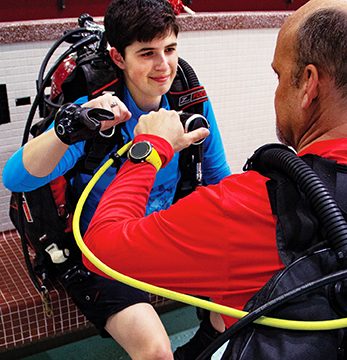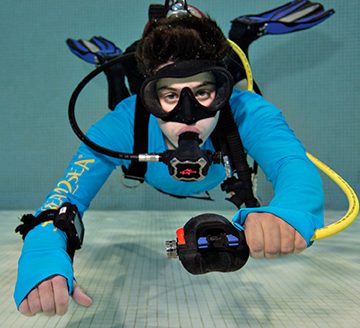THE DIVE INDUSTRY IS FULL OF DEBATES. Should you use a jacket-style, back-inflate, or backplate and wing buoyancy compensator? A canister light or a cordless light? A weight belt or integrated weights? Regular fins or split fins?
Dive manufacturers release new technology every year, and with new equipment comes differing opinions. Some are legitimate, such as standardized markings for gas content in cylinders. Others, such as air-integrated computers, are matters of personal preference and individual needs. One size rarely fits all.
For a traditional recreational configuration, divers wear the octopus (or safe second) on the right side. This second regulator is ready for rapid deployment if a diver’s buddy runs out of breathing gas, but does positioning it on the right allow optimal use in an emergency? This topic is another source of debate, and there are arguments for wearing an octopus on the left and the right.
Folklore says that the octopus was originally designed for divers to wear on and deploy from their left sides. Another tale claims that during a photo shoot for early marketing materials, the photographer realized that the desired shot was unachievable unless both models had their regulators on the same side. They switched the octopus to the right, the photos were published, and the rest is history. Yet another story says that divers reversed the sides due to a lack of available low-pressure ports on the first stage. There is little documentation of these tales, but something (or a combination of things) is responsible for creating or changing the industry status quo.
To assess the advantages of a particular configuration, we must first evaluate the purpose of the equipment in question. What is the main function of the octopus? Divers can use it to inflate a delayed surface marker buoy or as an alternate breathing device in the event of primary regulator failure, but the main purpose is for donating gas during an out-of-air emergency. Therefore, we must compare its function in the left and the right positions to determine which side is optimal. The following table compares the positions and highlights the advantages of wearing an octopus on the left. Note that this does not apply to a diver who uses a BCD-integrated octopus, an octopus that can work upside down (like a side-exhaust regulator), or a long hose and necklace configuration.
Octopus donation in a real out-of-gas emergency will likely be more chaotic and intense than any training exercise. An optimal equipment configuration could be the difference between life and death in these situations. Of course, change is often difficult to implement. We encourage divers to experiment and practice skills while wearing an octopus on the left to learn if that configuration is the correct choice for their dive needs.

When modifying any equipment configuration, it is important to first practice in confined water. Grab a buddy, go to a local pool, and practice deploying an octopus with your left hand. A local dive shop can assist divers who need assistance with reconfiguring their hose routing.
One of the benefits of wearing an octopus on the left is controlling the out-of-gas diver with your right hand, the dominant hand for most divers. This configuration brings the diver face-to-face with you and avoids the awkward S-turn necessary in the hose to deploy a right-side octopus when sharing breathing gas. Rehearse grabbing the out-of-gas diver’s shoulder strap with your right hand as you deploy the octopus.
Although pressing the purge button is discouraged, some circumstances may require it, so divers should practice that skill as well. Pay attention to where the hose travels — it should be just under the outside of your left arm. Focus on maintaining eye contact and proper positioning in front of the out-of-gas diver. Try positioning your index finger on the bridge of their mask to keep it in place.

Control is the common theme: control of the hose, control of the out-of-gas diver, control of the situation. Some tasks, such as maintaining eye contact, may be possible with the octopus on your right, but those processes can be nearly flawless when wearing it on your left.
The greatest challenge that faces the industry when rethinking the octopus’s positioning is the overwhelming number of divers who learned to wear it on the right. While this position is not necessarily incorrect, it is not ideal when wearing a typical recreational gear configuration. No training agency standard dictates wearing it on a particular side.
Divers are encouraged to question the status quo. Ask instructors or mentors for their thoughts and opinions to gather as much information as possible. With change comes resistance, and divers who decide to wear their octopus on the left should expect questions and comments from others. Ultimately, it is up to each diver to determine which position is optimal for their dive needs.
The industry will continue to debate the octopus’s correct positioning. Conversations about gear configurations should spark a healthy dose of curiosity in divers. Changing habits can be difficult, but the task is less daunting when divers educate their peers. With leadership, others follow, which is the only way to create genuine change.

Alert Diver - Q2 2022